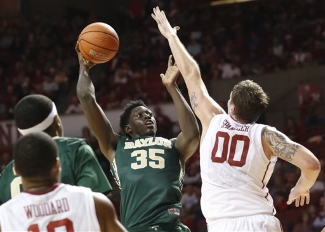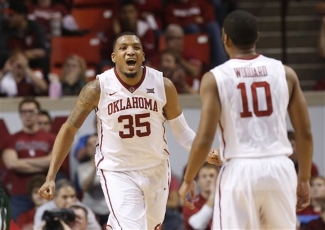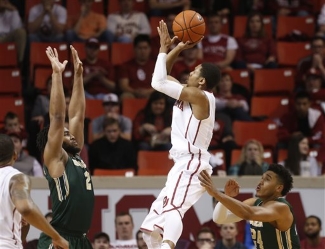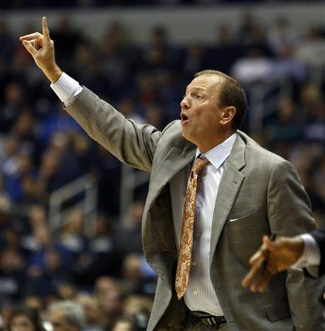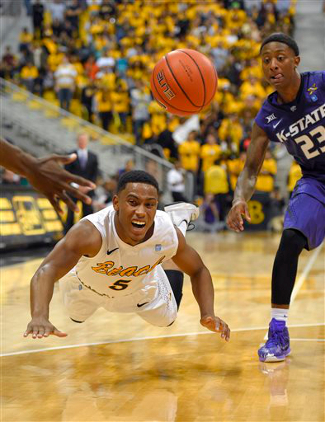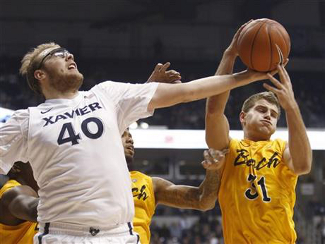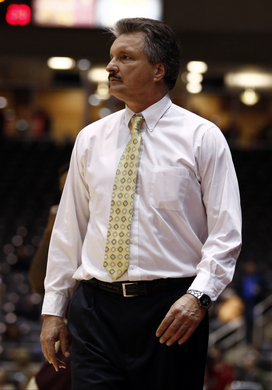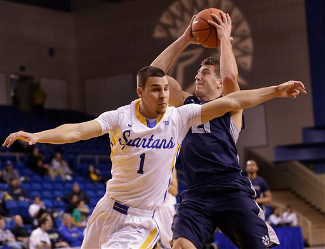Frank Erwin Center | Austin, TX | Tip: 8 P.M. CT | TV: ESPN Vegas: Texas -6 | KenPom: Texas, 67-64 (63%)
The Texas Longhorns are back in action at the Drum tonight, as they host rival Oklahoma in their Big 12 home opener. Both teams started conference play with a win on Saturday, as the Longhorns dispatched Texas Tech in Lubbock, while the Sooners handled Baylor in Norman. The conference is so deep this season that seven of its teams are currently found in the Top 25 of Ken Pomeroy’s rankings. With those teams so closely matched, the result of every game between the seven contenders can quickly swing the projections. Home teams are favored to win anywhere from 60% to 75% of the time in matchups between the top seven, and Pomeroy’s cumulative odds project a log-jam between those teams, with everyone bunched between 12-6 and 10-8 at season’s end. With the margin for error truly razor-thin in this year’s race, every head-to-head result will cast a long shadow. Oklahoma already defended its home court against another contender on Saturday, and now looks to make a big move with a road win against another. Last year, the Sooners took advantage of missed Texas free throws down the stretch to win in Austin for the first time since 2005. The Longhorns are certainly looking for revenge after being swept by their rival last year, but are also hoping to score their first RPI Top 50 win in three tries. With one of the NCAA tournament regionals taking place in Houston this year, stockpiling big wins for the résumé will take on added importance. By the Numbers The first thing you’ll notice when watching the Sooners or looking at their per-possession stats is that they love to get out and run. Oklahoma averages 70.1 possessions per 40 minutes, which is currently the 25th-fastest pace in the country. The Sooners look up and push the ball after both makes and misses by their opponent, and they love to shoot the transition three if they aren’t able to get all the way to the rim.
The Sooners make it very tough for opponents to score Oklahoma has also made vast improvements on the defensive side of the ball this season. The Sooners are currently allowing 0.872 adjusted points per possession, which is the 5th-best mark in the country. The team has not had a season with an adjusted defensive efficiency even ranked in the Top 50 since 2008-09, when Blake Griffin still patrolled the paint, so these kinds of defensive numbers are big news in Norman. The Sooner defense is led by a stable of quick guards that can play right in the jerseys of their opponents and extend pressure beyond the perimeter. Thanks to their speed and good help defense, the Sooners can recover quickly when opponents find an angle to penetrate. Inside, Oklahoma has undersized forwards by Big 12 standards, but they can still clean up shots that make it to the paint, as they’ve posted a 12.5% block rate, currently 69th-best in the nation. On the other end of the court, one glaring weakness for the Sooners is an inability to win back missed shots. With those undersized forwards and an offense that is focused on the perimeter, Oklahoma has quite a few one-and-done possessions each game. The Sooners win back just 29.5% of their missed shots, an OR% that is currently 227th out of 351 Division I teams. Since the Sooners have a perimeter-oriented offense, they also don’t earn many trips to the free throw line. Their free-throw rate of 30.3% is one of the 50 lowest in the country, which means that OU earns roughly three free throws for every 10 field goals they attempt. Despite having guards that all possess the ability to get to the rack, Oklahoma will often settle for jump shots rather than working the ball for a better look. Meet the Sooners At the point, 6’0″ sophomore Jordan Woodard (No. 10) sets the table for the Oklahoma offense. He pushes the ball really well in transition and has a knack for finding the open shooter before the defense gets set, leading to numerous threes. Woodard nearly broke the record for assists by a freshman at OU last year, and he’s off to another strong start this year, logging dimes on 27.6% of the baskets scored when he’s on the court. A common recipient of Woodard’s transition assists is 6’4″ junior guard Buddy Hield (No. 24). The Bahamian product is Oklahoma’s most consistent three-point threat, as he’s knocked down 38 of his 100 looks on the year. He also takes nearly 30% of the team’s shots when he’s on the floor, so the Sooners really struggle when he has an off night. Hield can be very streaky from beyond the arc, and often heats up in a hurry. He can miss his first four or five long-range attempts in a game, and then suddenly hit transition threes on back-to-back possessions. If the Sooners go on a big run during a ballgame, chances are very good that Hield provided a flurry of threes to spur the surge. The third man in Oklahoma’s three-guard look is 6’4″ junior Isaiah Cousins (No. 11). Cousins actually has a higher three-point percentage than Hield, but is a little more judicious with his shot selection. He’s coming off a 4-for-8 performance from long range against Baylor, and has connected on nearly 44% of his attempts this season. Inside, 6’8″ forward Ryan Spangler (No. 00) is a beast on the defensive glass, grabbing more than 20% of misses by opponents when he’s on the court. That stat doesn’t even tell the entire story, as his quick hops and persistent effort often lead to opponents fumbling the ball out of bounds and giving it to OU. Spangler also has a nice face-up game on offense, and is very accurate from long range. Although he only takes about one three-pointer per game, his 43.8% success rate makes opponents bite on his frequent shot fakes from the perimeter, which open up driving lanes for the big man. The Longhorn forwards have a very bad habit of biting on fakes, so they will have to stay grounded when Spangler catches the ball on the perimeter.
TaShawn Thomas has made an immediate impact at OU The final piece of Oklahoma’s starting five is Houston transfer TaShawn Thomas (No. 35), a 6’8″ senior who received a waiver from the NCAA to play right away for Coach Lon Kruger. Thomas is another face-up big man for Oklahoma, as he possesses adequate handles to drive against opposing forwards. His dribble is a little loose, so he is susceptible to the quick hands of guards helping down from the perimeter. Unlike Spangler, Thomas does not shoot it from behind the arc, but he can stretch the floor with midrange jumpers. The starting five for Oklahoma eat up a ton of the team’s minutes, but are all well conditioned enough to play long stretches at the team’s breakneck pace. However, with a thin, untested bench, foul trouble could be a problem against the depth of Texas. In the backcourt, OU’s main options are 6’4″ Frank Booker (No. 10) and 6’1″ JUCO transfer Dinjiyl Walker (No. 2), who combine for about 26 minutes per game. Booker is a very scrappy player who hustles all over the court and isn’t afraid to take a charge in the paint. Offensively, he lives on the perimeter, with more than three-quarters of his shots coming from outside. Unfortunately, he is not very accurate, with just 22% of his threes going down so far. Walker is a shifty guard that varies his speed and uses hesitation dribbles to find cracks in the defense. He also takes quite a few shots from outside, with nearly half of his looks coming from beyond the arc. Like Booker, Walker is not very accurate, having made just 28.6% of his threes through 13 games. Down low, the Sooners also have a pair of reserve options in the frontcourt. D.J. Bennett (No. 31) is a 6’8″ senior who is averaging about 10 minutes per game. He is a strong rebounder and has great timing for blocking shots, particularly as he comes over in help situations. However, his preference for trying to log blocks also leads to quite a few fouls, as he averages more than eight fouls per 40 minutes. Freshman Khadeem Lattin (No. 12) is 6’9″ and incredibly athletic, but has only played about 11 minutes per game. His biggest impact as a freshman has been on the defensive end, as he’s logged some impressive blocks when he’s wiped fast-break buckets right off the board after hustling back in transition. Like Bennett, Lattin still gets whistled quite a bit when defending inside, as he averages nearly six fouls per 40 minutes. Keys to the Game 1. Get back in transition – The Sooners take nearly 27% of their shots in transition, a rate that is currently 31st-highest in D-I, according to Hoop Math. Texas needs to get back in transition, quickly find the shooters, and stop the ball, as Hield and Cousins do not need much space to sink a three. While Oklahoma has shown patience when having to play half-court offense against a zone, they tend to settle for quick, contested jumpers against man-to-man defenses that stop them on the break. If the Longhorns can limit transition points and force Oklahoma into tough jumpers, their advantage on the glass should severely limit scoring chances for the Sooners. 2. Don’t turn it over – A big part of the challenge for Texas in stopping Oklahoma’s transition offense will be limiting the turnovers that have plagued them all season long. The Sooners don’t force a ton of miscues, but the Longhorns have proven that they can give it away even against low-pressure defenses. In addition to not giving OU runout opportunities by turning it over, the Longhorns also must avoid bad outside shots, as those can start breaks just as easily as bad passes can.
The Longhorns can’t lose track of Cousins or Hield 3. Stay glued to the shooters – Even though Thomas and Spangler have both shown the ability to knock down jumpers, the Longhorns should be content with letting those two take shots. Texas needs to focus on shadowing Hield and Cousins all over the court, and cannot allow them many open looks. The Horns had some issues with ball-screen defense against Stanford, which could definitely pose a problem again tonight. If Texas gets hung up on screens, or chooses to go under them, Hield and Cousins will quickly make them pay in this game. However, if the Longhorns can force that pair to take a bunch of challenged shots in order to earn their points, Oklahoma will find it much tougher to snag a road win tonight. 4. Pound it down low – Texas has a distinct advantage inside, and needs to try to get the ball into the paint for easy points. In addition to getting the offense going for Texas, a focus on scoring inside may also tag Spangler and Thomas with fouls. The Sooners don’t have much depth in the frontcourt, and the style of play differs quite a bit from their starters to their reserves. Bennett and Lattin don’t have the accuracy of Spangler and Thomas on long jumpers, so it makes it even easier for the Longhorns to defend when those players are used in screens for the OU shooters. If Spangler and Thomas are sitting on the bench for extended minutes tonight, the Longhorns have a good chance to defend their home court. [Ed: This post was revised after publishing to reflect the new rankings for both teams in the January 5th polls.] |








